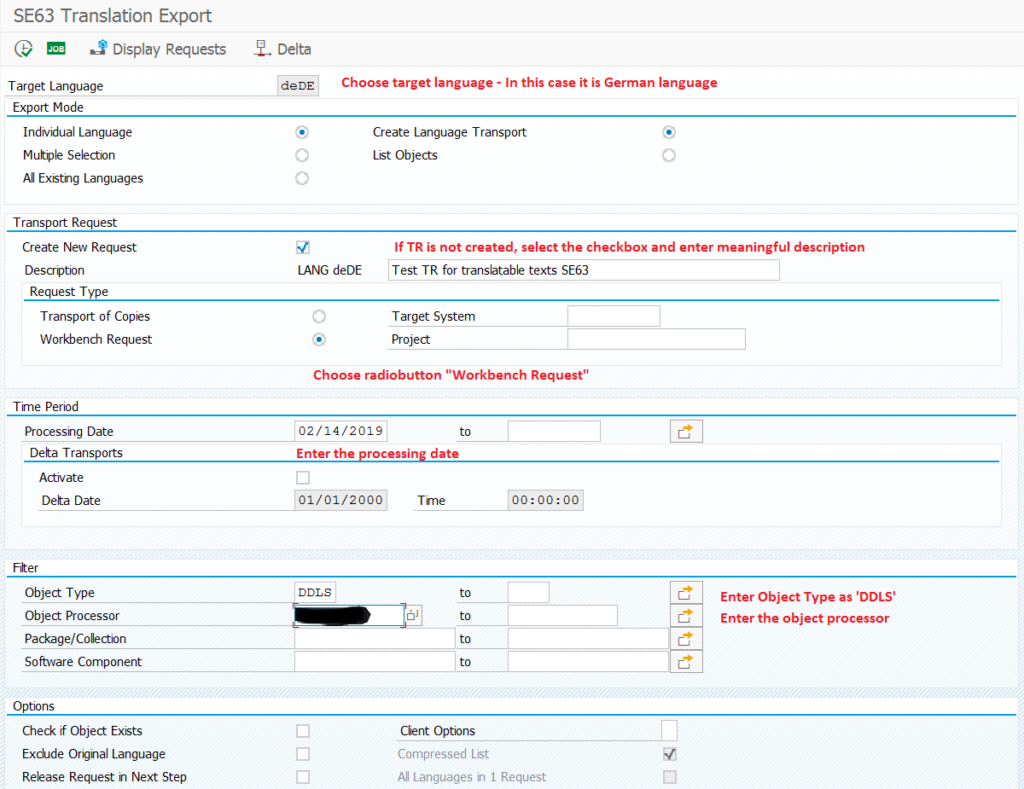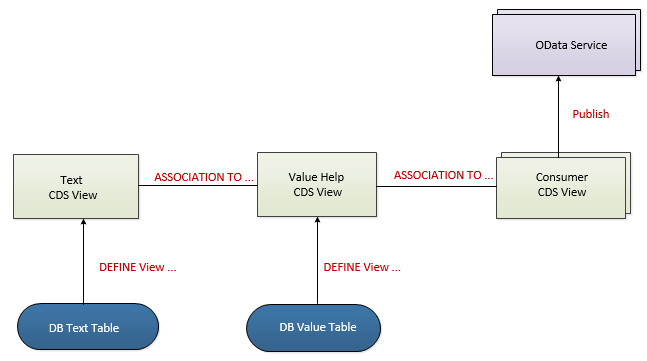怎么给 ABAP CDS 的值字段添加描述字段和帮助字段? 本文以 NW 7.52 上的 S_ODATA_EPMRA_SO_ANA 包里的 CDS 为例做讲解.
Field Labels and Descriptions
ABAP CDS 暴露出来字段的标签和描述是来自其对应的 ABAP Dictionary data elements 标签和描述, 但有时想要重新定义或者本身没有定义 data elements 的字段,则他们的 Labels 和 Descriptions 就需要 Annotations 进行定义了。使用注解 @EndUserText.label 定义字段的 label text 和用 @EndUserText.quickInfo 定义详细的解释,用于辅助功能提示或者 tooltip 这样的显示内容里。
...
@EndUserText.label: 'List with Sales Orders' -- Annotation at the view level
DEFINE VIEW SalesOrderHeader as ... {
...
-- Annotation at the field level
@EndUserText: { label: 'Sales Order Header', quickinfo: 'Sales Order Header that provides data relevant for all items' }
SalesOrder as Header;
...
既然是文本型的就需要支持多语言功能, @EndUserText 支持在 SE63 传统的 ABAP 系统功能中进行翻译
- 打开 SE63 选择 Short Texts -> A5 User Interface Texts -> DDLS CDS Views
- 输入 CDS name 和 Source and Target Language 点击编辑进行翻译
Unfortunately, translations are not added to TR automatically and need to be added manually.
- 执行 SLXT, 如下图说明

执行后便将翻译保存到了 TR 里
参考阅读
- CDS Part 14. ABAP Annotations for Translatable Texts in CDS Views
- Adding Field Labels and Descriptions
Text
Language-independent
首先看一下语言无关, 就是不区分语言的描述字段, 怎么设置?
@ObjectModel.text.element[] 可以定义一个字段的描述字段, 如下面 Customer 字段对应的文本字段是 CompanyName
@AbapCatalog: { sqlViewName: 'SEPMRACALPCUST', compiler.compareFilter: true }
@AccessControl.authorizationCheck: #CHECK
@EndUserText.label: 'Customer'
define view SEPMRA_C_ALP_Customer
as select from SEPM_I_CUSTOMER_E as Customer
{
@ObjectModel: { text.element: [ 'CompanyName' ] }
key cast( Customer as snwd_customer_id preserving type ) as Customer,
@Semantics: { name.fullName: true }
CompanyName,
...
}
SADL - First text field listed in the annotation array will be handled as descriptive text of the annotated field in OData exposure scenarios.
之后通过 SADL 暴露出来的 OData Service 的 metadata 就如下, Customer 字段的 sap:text="CompanyName" 属性就指向了 CompanyName 字段
<EntityType Name="SEPMRA_C_ALP_CustomerType" sap:label="Customer" sap:content-version="1">
<Key>
<PropertyRef Name="Customer"/>
</Key>
<Property Name="Customer" Type="Edm.String" Nullable="false" MaxLength="10" sap:display-format="UpperCase" sap:text="CompanyName" sap:label="Customer" sap:quickinfo="EPM: Customer ID"/>
<Property Name="CompanyName" Type="Edm.String" MaxLength="80" sap:label="Company" sap:quickinfo="EPM: Company Name"/>
</EntityType>
这样 Fiori Smart 系列的 Elements 在用到 Customer 字段时会自动显示其对应的文本字段 CompanyName 的值 ( 或者是合起来的值 CompanyName(Customer) )
NOTE: The usage of this annotation
@ObjectModel.text.element[]excludes the usage of@ObjectModel.text.association.
旧的
@Consumption.labelElement: 'CompanyName'可以指定文本字段, 但不建议使用了.
Text Associations
对于与语言相关的文本字段则需要用另外的方式, 使用 @ObjectModel.dataCategory: #TEXT 与 @ObjectModel.text.association: '_Text' 结合的方式可以做到自动获取语言相关的文本字段值, 如下
@EndUserText.label: 'EPM Demo: Country Texts'
@ObjectModel.dataCategory: #TEXT
@ObjectModel.representativeKey: 'Country'
define view SEPM_I_CountryText
as select from t005t
association [0..1] to SEPM_I_Language as _Language
on $projection.Language = _Language.Language
association [1..1] to SEPM_I_Country as _Country
on $projection.Country = _Country.Country
{
@Semantics.language: true
key spras as Language,
key land1 as Country,
@Semantics.text: true
landx50 as CountryName,
@Semantics.text: true
natio50 as NationalityName,
@Semantics.text: true
landx as CountryShortName,
@Semantics.text: true
natio as NationalityShortName,
_Language,
_Country
}
@ObjectModel.dataCategory: #TEXT注释了此 View 是一个文本视图@Semantics.language: true指定一个字段是语言字段, 在 ABQL join Data and Text 时此字段将作为过滤条件默认等于登陆语言, 这样就没必要使用 Session 里的 language 或者输入参数进行语言过滤了@Semantics.text: true指示文本字段, SADL 暴露 OData 时将第一个文本字段作为其字段的文本字段
SAP 推荐的规则
- Text views should only be defined for language-dependent texts and are annotated with
@ObjectModel.dataCategory: #TEXT.- At least one non-key field has to be defined as a text field in a text view. A text field is annotated with
@Semantics.text: true- The language field that is used in the text view must be a key field.
- The language field is annotated with
@Semantics.language: true.- The language code represents the corresponding ABAP internal format (like
SPRAS). In particular, do not use external formats/ISO codes!- The text view defines a representative key field (a field for which the text view provides texts).
- The name of the text view ends either with …Text or …T.
下面就是在其他视图中使用此文本视图, 使用注解 @ObjectModel.text.association: '<association>' 来指定字段的文本视图关联
@EndUserText.label: 'EPM Demo: Country'
define view SEPM_I_Country
as select from t005
association [0..*] to SEPM_I_CountryText as _Text
on $projection.Country = _Text.Country
{
@ObjectModel.text.association: '_Text'
key land1 as Country,
_Text
}
@ObjectModel.text.association: '_Text'注解了Country字段,_Text是关联的文本视图SEPM_I_CountryText_Text并且要将关联暴露出去
然后在生成的 OData metadata 里将会是这样的
<EntityType Name="SEPMRA_C_ALP_CountryVHType" sap:label="Country" sap:content-version="1">
<Key>
<PropertyRef Name="Country"/>
</Key>
<Property Name="Country" Type="Edm.String" Nullable="false" MaxLength="3" sap:display-format="UpperCase" sap:text="CountryT" sap:label="国家/地区代码"/>
<Property Name="CountryT" Type="Edm.String" MaxLength="50" sap:attribute-for="Country" sap:label="Name"/>
</EntityType>
CountryT字段是 SADL 自动会Country增加的文本字段, 并且有了sap:text="CountryT"和sap:attribute-for="Country"两个属性
Foreign Key Associations
Value Help
Based on Foreign Key Relationship
Text Provider
 首先要建一个 Text provider, 因为我们使 Value Help 可以搜索, 所以除了上面讲到的 Text 相关的注解外还要为 Text View 加上
首先要建一个 Text provider, 因为我们使 Value Help 可以搜索, 所以除了上面讲到的 Text 相关的注解外还要为 Text View 加上 @Search.searchable: true 来表示 View 可以被搜索和 @Search.defaultSearchElement: true 来表示字段可以被搜索, 字段还可以加上 @Search.fuzzinessThreshold: 0.8 表示搜索的模糊匹配程度
@AbapCatalog.sqlViewName: 'ZDEMO_I_T'
@ObjectModel.dataCategory: #TEXT
@ObjectModel.representativeKey: 'UnitOfMeasure'
@Search.searchable: true
define view ZDEMO_I_Text
as select from t006a as TextProvider
{
key TextProvider.msehi as UnitOfMeasure,
@Semantics.language: true // identifies the language
key TextProvider.spras as Language,
@Semantics.text: true // identifies the text field
@Search.defaultSearchElement: true
@Search.fuzzinessThreshold: 0.8
TextProvider.mseht as Name
}
Value Help Provider
还要为 Value Help 建个 View, 此 View 需要 @Search.searchable: true 来表示可以被搜索, 然后用 @ObjectModel.text.association: '_Text' 和 @Search.defaultSearchElement: true 标注一个字段的文本视图和可以被搜索
@AbapCatalog.sqlViewName: 'ZDEMO_I_VH'
@Search.searchable: true
@EndUserText.label: 'Unit of Measure Value Help'
define view ZDEMO_I_ValueHelp
as select from t006 as ValueProvider
association [0..*] to ZDEMO_I_Text as _Text
on $projection.UnitOfMeasure = _Text.UnitOfMeasure
{
@ObjectModel.text.association: '_Text'
@Search.defaultSearchElement: true
key msehi as UnitOfMeasure,
// association
_Text
}
Consumer View
最后在需要加 Value Help 的 View 里把它加上, 关联上 Value provider 视图并用 @ObjectModel.foreignKey.association: '_QuantityUnitValueHelp' 把它标注在需要的字段上, 最后别忘了把此 association 暴露出去
define view ZDEMO_C_ValueHelp_Demo
as select from SalesOrderItem as Document
/* Association to quantity unit value help provider */
association [0..1] to ZDEMO_I_ValueHelp as _QuantityUnitValueHelp
on $projection.QuantityUnitCode = _QuantityUnitValueHelp.UnitOfMeasure
...
{
/* Field list */
...
@Semantics.unitOfMeasure: true
@ObjectModel.foreignKey.association: '_QuantityUnitValueHelp'
Document.QuantityUnitCode,
...
/* List of associations */
...
_QuantityUnitValueHelp
}
然后在生成的 OData 的 metadata 里便会出现三个新信息
- Value Help 的 EntityType
- Association
Common.ValueListAnnotation
如果使用 Fiori Smart 系列的 Elements 便会出来字段的 Value Help 如下图

Modelled View
这种方式就简单一些, 首先创建一个可以被搜索的 Value Provider, 加上 @Search.searchable: true, @Search.defaultSearchElement: true, @Search.fuzzinessThreshold: 0.8
@EndUserText.label: 'Business Partner Value Help'
@Search.searchable: true
define view ZDEMO_I_BP_ValueHelp as select from SEPM_I_BusinessPartner_E {
key BusinessPartner,
BusinessPartnerRole,
@Search.defaultSearchElement: true
@Search.fuzzinessThreshold: 0.8
CompanyName,
LegalForm,
EmailAddress
}
然后再用 @Consumption.valueHelp: '_BusinessPartnerValueHelp' 使用上就行了, 别忘了暴露出 association
define view ZDEMO_C_BP_CONSUMER as select from SEPM_I_SalesOrder_E as SO
// Association to BP value help
association [0..1] to ZDEMO_I_BP_ValueHelp as _BusinessPartnerValueHelp
on $projection.BusinessPartner = _BusinessPartnerValueHelp.BusinessPartner
...
{
/* Field list */
...
@Consumption.valueHelp: '_BusinessPartnerValueHelp'
SO.BusinessPartner,
...
/* List of associations */
...
_BusinessPartnerValueHelp
}
SAP Value List
standard or fixed-values
Comments